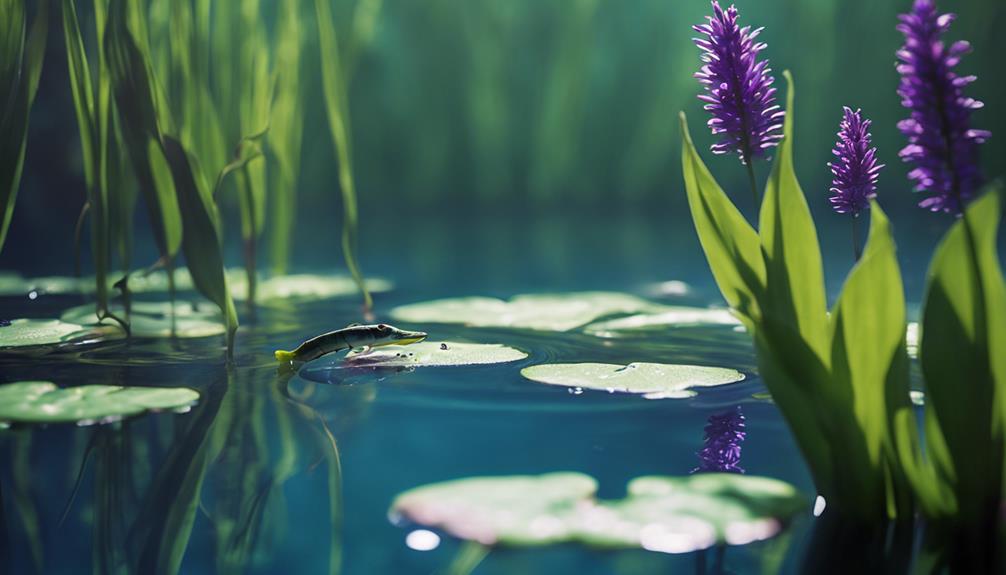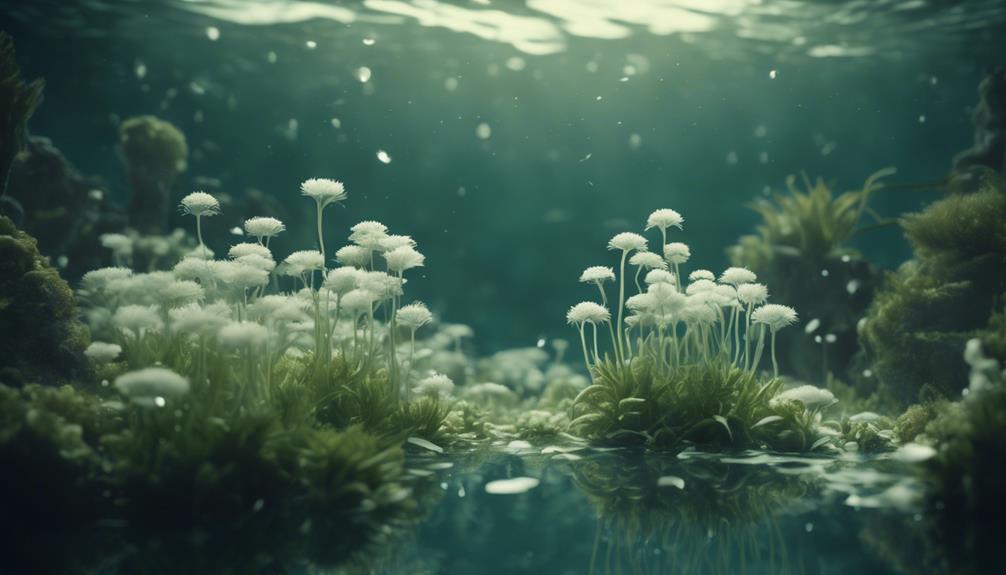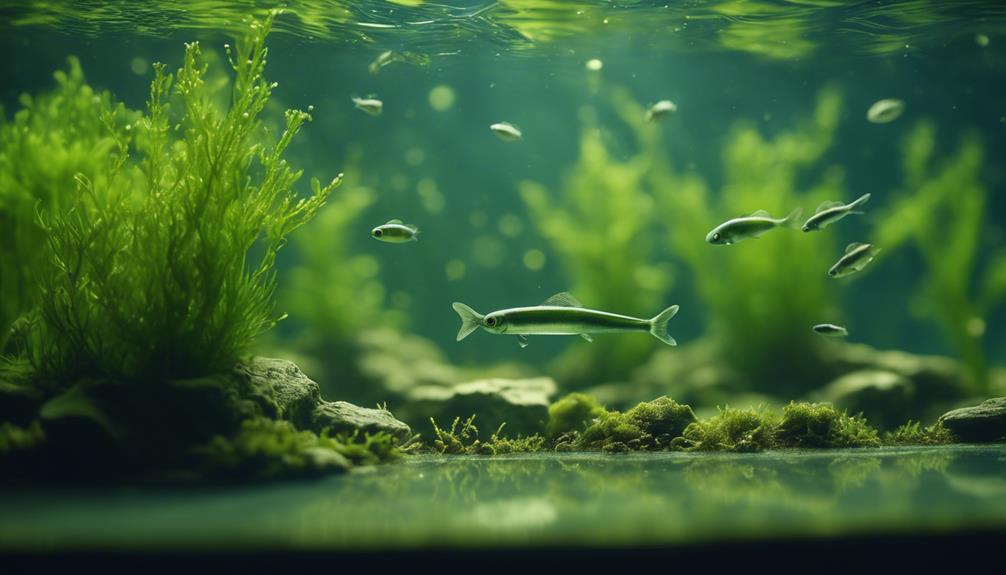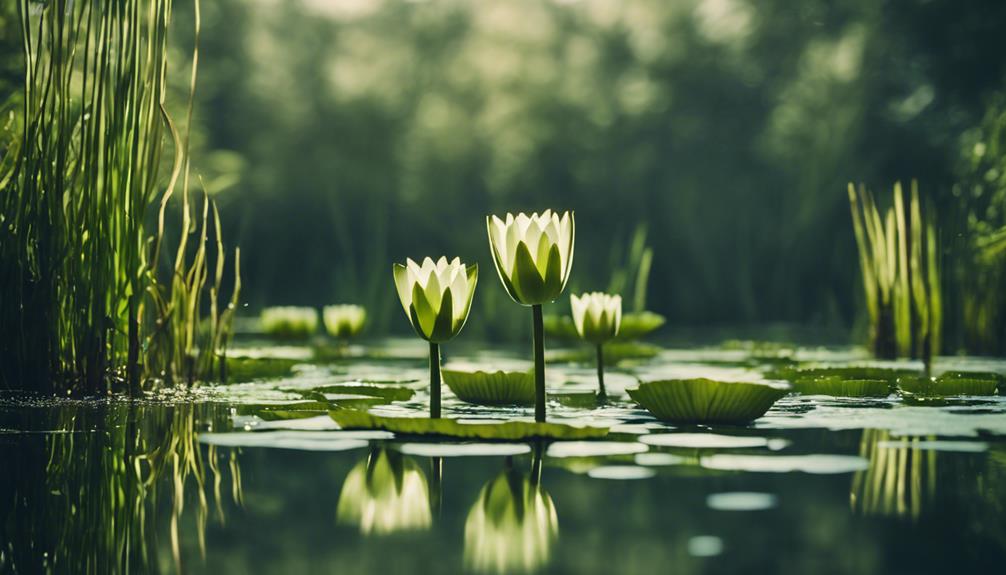You can maintain a healthier and more balanced water system by incorporating specific aquatic plants that work in harmony to clarify and oxygenate the water, absorb excess nutrients, and create a thriving ecosystem. Duck potato, American Pondweed, Pickerel Weed, Water Wisteria, Cabomba, Anacharis, and Hornwort are seven essential plants that can help you achieve this. Each plant plays a unique role, from filtering and nutrient absorption to oxygen production and microorganism control. By combining these plants, you'll be well on your way to a clearer, healthier water system. Now, discover how each plant contributes to a thriving aquatic ecosystem.
Table of Contents
Key Takeaways
- Certain aquatic plants, like Cabomba and Anacharis, can absorb up to 95% of excess nutrients, including nitrogen and phosphorus, from the water.
- Plants like Water Wisteria and Anacharis can boost oxygen levels, with some producing up to 10 liters of oxygen per day during peak growth.
- Aquatic plants like Duck potato and American Pondweed provide habitat for pond animals and beneficial microorganisms, benefiting the entire ecosystem.
- Rapidly growing plants like Anacharis absorb nutrients quickly, preventing algae growth and maintaining water clarity and quality.
- A diverse range of aquatic plants, including Hornwort and Pickerel Weed, can create a self-sustaining ecosystem, supporting a thriving food chain and ecosystem balance.
Duck Potato for Water Clarity
By incorporating duck potato into your pond's ecosystem, you can harness its natural filtering abilities to achieve clearer, healthier water.
This aquatic plant thrives in water 6-12 inches deep, making it an ideal addition to your pond. As it grows, duck potato absorbs excess nutrients, reducing algae growth and stabilizing the pond's ecosystem.
This process promotes water clarity, creating a healthy environment for aquatic life to flourish.
As a natural filtration system, duck potato removes impurities and pollutants from the pond water, minimizing the need for chemical treatments.
By planting duck potato, you're taking a significant step towards creating a self-sustaining ecosystem that requires minimal intervention.
This means you can enjoy clearer, more pristine water without the hassle of constant maintenance.
With duck potato, you're not only improving water clarity but also providing a habitat for pond animals, which can benefit from its wide leaves and white flowers.
American Pondweed's Filtering Power
You can effectively harness American Pondweed's filtering power to remove excess nutrients from your pond water, promoting a clearer and healthier aquatic environment.
This submerged aquatic plant is capable of absorbing up to 60% of excess nutrients, including nitrogen and phosphorus, from the water.
With stems that can grow up to 10 feet long, American Pondweed provides a large surface area for nutrient absorption, making it an ideal choice for pond water clarification.
It thrives in water with a pH range of 6.5-8.5 and temperatures between 65-85°F (18-29°C), making it a versatile option for various aquatic environments.
By incorporating American Pondweed into your pond or water system, you can reduce the need for chemical treatments and create a more sustainable, natural approach to water clarification.
Additionally, its leaves and stems serve as a food source for aquatic animals, such as fish and ducks, adding to its ecological benefits in maintaining a balanced ecosystem.
Pickerel Weed's Nutrient Absorption

As you explore the benefits of Pickerel Weed, you'll discover its vital role in water purification, particularly in absorbing excess nutrients that can harm aquatic ecosystems.
You'll learn how its efficient root system enables the plant to remove pollutants, making it an effective natural solution for clearer water systems.
Water Purification Role
One of the most significant benefits of Pickerel Weed in water systems is its ability to absorb excess nutrients, including nitrogen and phosphorus, from the water.
This natural process plays a vital role in water purification, as it reduces the risk of algal blooms and maintains clear and healthy water for aquatic life.
By absorbing up to 60% of nitrogen and 70% of phosphorus, Pickerel Weed acts as an effective natural filter, improving water quality and creating a sustainable solution for pond owners and managers.
As you incorporate this plant into your water system, you'll notice a significant decrease in organic matter, further contributing to clearer and healthier water.
By harnessing the power of Pickerel Weed, you can create a natural and balanced ecosystem, reducing the need for chemical treatments and other costly interventions.
This plant's impressive nutrient-absorbing capabilities make it an essential component of any water system, providing a natural and effective way to maintain clear and thriving water.
Root System Efficiency
Pickerel Weed's root system, consisting of rhizomes and fibrous roots, efficiently absorbs excess nutrients from the water by increasing the surface area for nutrient uptake. This extensive root system allows the plant to thrive while helping to maintain clearer water.
As submerged plants like Pickerel Weed absorb nutrients, they reduce the amount of excess nutrients available for algae growth, consequently preventing water cloudiness. When you introduce these plants into your water system, they help oxygenate the water, creating a healthier environment for aquatic life.
By absorbing excess nutrients, Pickerel Weed reduces the risk of algae blooms, which can deplete oxygen levels and harm aquatic life. By incorporating Pickerel Weed into your water system, you're taking a significant step towards maintaining a balanced ecosystem.
These plants help create a thriving environment where aquatic life can flourish, and you can enjoy a clearer, healthier water system.
Water Wisteria's Oxygen Boost
Some aquarium owners may not realize that adding Water Wisteria to their tank can substantially boost oxygen levels, with research showing a remarkable 20% increase in dissolved oxygen within just 24 hours.
This significant increase in oxygen can greatly benefit your aquatic environment, supporting the health and well-being of your fish and other aquatic creatures.
As you introduce Water Wisteria to your tank, you can expect improved water clarity, as this plant is known to absorb excess nutrients like nitrogen and phosphorus, preventing algae growth.
By removing these pollutants, Water Wisteria helps maintain a balanced ecosystem, creating a thriving environment for your aquatic life.
With its ability to produce a substantial amount of oxygen, Water Wisteria is an excellent addition to any aquarium or pond, promoting a healthy and vibrant aquatic environment that you can be proud to call your own.
Cabomba's Excess Nutrient Removal

By incorporating Cabomba into your aquatic system, you effectively introduce a powerful natural filter capable of removing excess nutrients like nitrogen and phosphorus from the water.
This submerged aquatic plant has been shown to be highly efficient in absorbing these nutrients, with studies demonstrating a removal rate of up to 95% of nitrogen and 85% of phosphorus from wastewater.
Cabomba's high growth rate, doubling its biomass in just 2-3 days, allows it to quickly absorb excess nutrients from the water, making it an effective natural filtration system.
Additionally, Cabomba is also capable of removing heavy metals like lead, copper, and zinc from water, making it a valuable tool for cleaning up polluted water systems.
When used in conjunction with other aquatic plants, Cabomba has been shown to increase the overall removal efficiency of excess nutrients and pollutants from water.
Anacharis's Rapid Growth Benefits
As you explore the benefits of Anacharis, you'll discover that its rapid growth rate has several advantages for water systems.
This plant's ability to absorb nutrients quickly, produce oxygen at an impressive rate, and uptake nutrients with ease makes it an invaluable asset for maintaining water clarity.
Fast Absorption Rates
Anacharis can rapidly colonize your water system, absorbing excess nutrients and pollutants at an incredible pace, with a growth rate of up to 5 cm per day. This means you can expect a significant reduction in water pollutants in a short amount of time.
As Anacharis grows, it absorbs carbon dioxide from the water, reducing algae growth and promoting clean water conditions. In fact, this plant can absorb up to 95% of heavy metals, 85% of ammonia, and 75% of phosphorus from the water, making it an effective natural filtration system.
With its ability to produce up to 10,000 roots per plant, Anacharis can absorb large amounts of nutrients and pollutants, leaving your water system cleaner and healthier. By introducing Anacharis to your water system, you can expect a rapid improvement in water quality, making it an ideal habitat for fish and other aquatic life.
With its fast absorption rates, Anacharis is an excellent choice for anyone looking to create a thriving and balanced water ecosystem.
Oxygen Production Boost
During peak growth, Anacharis's rapid colonization of your water system produces a substantial oxygen surplus, generating up to 10 liters of oxygen per day.
This remarkable oxygen production boost is essential for maintaining a healthy Water Garden. As an effective natural oxygenator, Anacharis plays a vital role in sustaining aquatic life.
By introducing this plant to your water system, you can create a thriving environment where fish and other aquatic organisms can flourish.
As you cultivate Anacharis, you'll notice a significant increase in oxygen levels, which will benefit the entire ecosystem.
This submerged aquatic plant is effective in absorbing carbon dioxide, a process that promotes oxygen production. By doing so, Anacharis helps to stabilize the water's pH levels, creating a more balanced environment.
With its rapid growth rate, Anacharis can quickly establish itself as a reliable oxygen source, providing a natural solution for maintaining water clarity and quality.
Nutrient Uptake Capacity
Your water system's nutrient levels will substantially benefit from Anacharis's rapid growth, which enables it to absorb excess nutrients at an exceptional rate.
This fast-growing aquatic plant can absorb up to 15 times more nitrogen and phosphorus than other aquatic plants, making it an effective natural filter for your pond water.
As Anacharis grows at a rate of 1-2 inches per day, it quickly absorbs excess nutrients, preventing algae growth and reducing the risk of algae blooms.
By outcompeting algae for essential nutrients, Anacharis maintains your water stays clear and healthy.
Additionally, this plant provides shelter and habitat for beneficial aquatic organisms, such as fish and invertebrates.
By incorporating Anacharis into your pond ecosystem, you'll reduce the need for chemical treatments and maintain clearer, healthier water.
With Anacharis's exceptional nutrient uptake capacity, you can rest assured that your water system will thrive.
These plants will help you achieve a balanced ecosystem, free from algae blooms, and enjoy a clearer, more vibrant water environment.
Hornwort's Microorganism Control

Hornwort's dense foliage and intricate root system team up to create a thriving habitat for beneficial microorganisms, which break down organic matter and consume excess nutrients, ultimately contributing to clearer water systems.
As you introduce Hornwort to your water system, you can expect a significant reduction in organic matter and excess nutrients, paving the way for crystal-clear water without the nuisance of algal blooms.
This plant species' unique ability to support a diverse range of microorganisms creates a self-sustaining ecosystem, where beneficial microbes thrive and outcompete harmful ones.
The result is water that's not only clear but also teeming with life.
By providing a habitat for zooplankton, fish, and other aquatic organisms, Hornwort creates a thriving food chain that supports the entire ecosystem.
With regular pruning and maintenance, you can maintain that your Hornwort plants continue to support a healthy balance of microorganisms, keeping your water system in pristine condition.
Frequently Asked Questions
What Plant Keeps Water Clean?
You're wondering what plant keeps water clean? Well, you'll be pleased to know that Water Lilies and other Aquatic Plants, like Marine Algae, are natural filters, while Bamboo Filters and Floating Islands also play a significant role in purifying water.
Do Plants Help With Water Clarity?
You'll find that plants play a vital role in maintaining water clarity through water absorption, supporting aquatic ecosystems, and providing natural filtration. By harnessing these ecofriendly solutions, you can substantially improve freshwater quality.
What Plants Help With Water Pollution?
You'll be stunned to know that certain plants can remove up to 90% of nitrate-N from water! Plants like duckweed, hornwort, and cattail excel in water absorption, supporting aquatic ecosystems, algae control, flood prevention, and coastal restoration.
What Plants Remove Bacteria From Water?
You're looking for plants that remove bacteria from water? Certain species, like cattails and horsetails, act as effective water purifiers, aquatic filters, biofilm breakers, and microbe absorbers, making them freshwater saviors in the fight against waterborne pathogens.
Conclusion
You've learned about the 7 essential plants for clearer water systems.
These aquatic plants are natural solutions for maintaining water quality.
Did you know that according to the EPA, one acre of aquatic plants can remove up to 60 kg of nitrogen and 10 kg of phosphorus from the water annually?
By incorporating these plants into your water management strategy, you'll be taking a significant step towards a healthier and more sustainable ecosystem.

